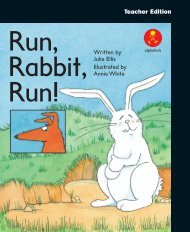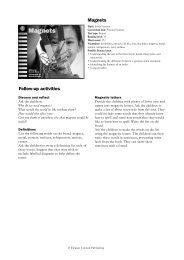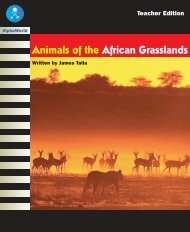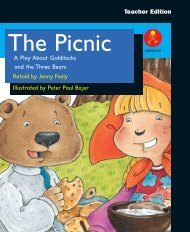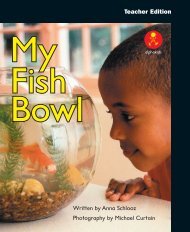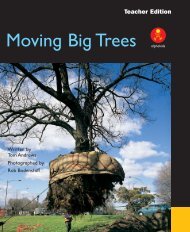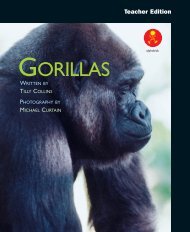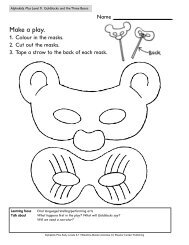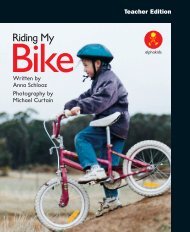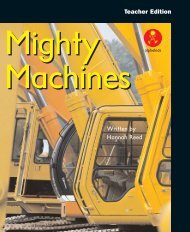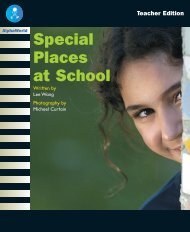Seeds On the Move
Seeds On the Move
Seeds On the Move
- No tags were found...
You also want an ePaper? Increase the reach of your titles
YUMPU automatically turns print PDFs into web optimized ePapers that Google loves.
Published edition© Eleanor CurtainPublishing 2003First published 2003Apart from any fair dealingfor <strong>the</strong> purposesof study, research, criticismor review, as permittedunder <strong>the</strong> Copyright Act ofAustralia, no part of thisbook may be reproduced byany process, or transmittedin any form, withoutpermission of <strong>the</strong> copyrightowner. Where copies of partor <strong>the</strong> whole of this book aremade under Part VB of <strong>the</strong>Copyright Act, <strong>the</strong> lawrequires that records of suchcopying be kept and <strong>the</strong>copyright owner is entitledto claim payment.Developed byEleanor Curtain PublishingText: Jenny FeelyConsultant: Susan HillDesigned byAlexander StittProduction byPublishing SolutionsPrinted in Hong KongISBN 0 7253 2950 5Pack ISBN 0 7253 2338 8(6 Student Books +1 Teacher Edition)1 2 3 4 5 6 7 8 903 04 05?How to use this bookBefore reading: TalkthroughTalk through <strong>the</strong> book with <strong>the</strong> children. Encourage<strong>the</strong>m to predict <strong>the</strong> text from <strong>the</strong> pictures and tothink about <strong>the</strong> information <strong>the</strong>y provide. Direct <strong>the</strong>children’s attention to aspects of <strong>the</strong> text that maychallenge <strong>the</strong>m. Support <strong>the</strong> children to deal with<strong>the</strong>se challenges by asking <strong>the</strong> Talkthrough questionson each page.During reading: Observe and supportObserve <strong>the</strong> children as <strong>the</strong>y read. As needed,support children by assisting <strong>the</strong>m to discover anduse reading strategies and cues to solve problemsand respond to reading challenges that arise in <strong>the</strong>text. Encourage <strong>the</strong>m to monitor <strong>the</strong>ir own reading.Interruptions to <strong>the</strong> child’s reading should beminimal and focused on a specified learning need.After reading: Checkingcomprehension, responding to textTo fur<strong>the</strong>r develop children’s understanding of <strong>the</strong>text, select activities found on <strong>the</strong> inside back cover.These whole text, sentence and word level activitiesreinforce <strong>the</strong> teaching focus of this book. Assessmentideas are provided to assist with planning for fur<strong>the</strong>rteaching.
<strong>Seeds</strong> <strong>On</strong> <strong>the</strong> <strong>Move</strong><strong>Seeds</strong> grow on plants<strong>Seeds</strong> come from plants.When seeds are ripe <strong>the</strong>y leave <strong>the</strong> plantsand find a new place to grow.?4TalkthroughThis is chapter one. It is called ‘<strong>Seeds</strong> grow on plants’.It tells us that seeds grow on plants. It says that seedsleave <strong>the</strong> plants <strong>the</strong>y grow on to find a new place togrow. Look at <strong>the</strong> pictures. Where are <strong>the</strong> seeds?4
5Observe and supportCan <strong>the</strong> child identify different features on <strong>the</strong> page?Can you show me <strong>the</strong> chapter heading?How did you know it was <strong>the</strong> chapter heading?5
<strong>Seeds</strong> <strong>On</strong> <strong>the</strong> <strong>Move</strong><strong>Seeds</strong> are different shapes and sizes.<strong>Seeds</strong> are moved in different ways.?6TalkthroughWhat shape are <strong>the</strong> seeds on this page? What size are<strong>the</strong>y?The book says that seeds of different shapes and sizesmove in different ways.6
7Observe and supportDoes <strong>the</strong> child interpret <strong>the</strong> visual information on <strong>the</strong>page?What shape can seeds be? How do you know?Point out a particular seed in one picture.How do you think this seed would move?7
<strong>Seeds</strong> <strong>On</strong> <strong>the</strong> <strong>Move</strong><strong>Seeds</strong> are moved by windSome seeds are movedby <strong>the</strong> wind.These seeds are small and light.When <strong>the</strong> wind stops blowing,<strong>the</strong>se seeds fall.?8TalkthroughLook at <strong>the</strong> pictures. What is making <strong>the</strong>se seeds move?What would this chapter be called? What shape andsize would seeds need to be to be moved by <strong>the</strong> wind?8
9Observe and supportDoes <strong>the</strong> child understand <strong>the</strong> literal meaning of <strong>the</strong>text?What are seeds that are moved by <strong>the</strong> wind like? Whathappens when <strong>the</strong> wind stops blowing? Where does <strong>the</strong>book say this?9
<strong>Seeds</strong> <strong>On</strong> <strong>the</strong> <strong>Move</strong><strong>Seeds</strong> are moved by animalsSome seeds are moved by animals.Some seeds stick to <strong>the</strong> fur or wool of animals.O<strong>the</strong>r seeds are eaten by animals.?10TalkthroughSome seeds are moved by animals. Some seeds stick toanimals’ fur or wool. Animals eat o<strong>the</strong>r seeds.10
11Observe and supportCan <strong>the</strong> child read <strong>the</strong> text fluently?Model fluent reading for <strong>the</strong> child.Can you read it with me? Can you make it sound liketalking? Can you read it by yourself?11
<strong>Seeds</strong> <strong>On</strong> <strong>the</strong> <strong>Move</strong><strong>Seeds</strong> are moved by waterSome seeds are moved by water.They float on <strong>the</strong> top of <strong>the</strong> wateruntil <strong>the</strong>y reach land.?12TalkthroughThese seeds are moved by water. They can float. Thewater takes <strong>the</strong>m to land.12
13Observe and supportCan <strong>the</strong> child draw inferences from <strong>the</strong> text?Some plants have seeds that can float. Where would<strong>the</strong>se plants grow? Why?13
<strong>Seeds</strong> <strong>On</strong> <strong>the</strong> <strong>Move</strong>New plants grow<strong>Seeds</strong> are moved in many ways.When <strong>the</strong> seeds stop moving<strong>the</strong>y can start growing.Some seeds grow into new plants.?14TalkthroughThis page tells us about what happens when <strong>the</strong> seedsstop moving. They can start growing.14
15Observe and supportDoes <strong>the</strong> child understand conditional language?Do all seeds grow into plants? Which part of <strong>the</strong> booktells us that?15
<strong>Seeds</strong> <strong>On</strong> <strong>the</strong> <strong>Move</strong>?TalkthroughThis is a flow chart. It shows us <strong>the</strong> life cycle of aplant.Point out <strong>the</strong> arrows and <strong>the</strong> continuous nature of<strong>the</strong> diagram.From seed to plantseeds move to a new placeseeds grow on plantroots and leavesgrow from seed16plant grows biggerComprehension checkWhat are some of <strong>the</strong> ways that seeds from plantsare moved from one place to ano<strong>the</strong>r?What happens to some of <strong>the</strong> seeds?What would happen if seeds couldn’t move awayfrom <strong>the</strong> plant <strong>the</strong>y grew on?16
Responding to textHave children use constructionmaterials to design, build anddisplay three seeds. <strong>On</strong>e that could bemoved by wind, one that could bemoved by animals and one that couldbe moved by water. Ask children towrite a caption to go with <strong>the</strong>ir display.Have <strong>the</strong> children write aboutone of <strong>the</strong> seeds in <strong>the</strong>introduction, discussing how <strong>the</strong>ymight move away from <strong>the</strong> plant <strong>the</strong>ygrew on. Encourage children to use <strong>the</strong>book as a model.Children could build lists ofwords featuring <strong>the</strong> long /e/sound as represented by <strong>the</strong> digraphs‘ee’, ‘ea’ and ‘e-e’, such as seed, sealeat, <strong>the</strong>se.For fur<strong>the</strong>r literacy activities see<strong>the</strong> accompanying book, AlphaWorldLiteracy Learning Activities: EarlyReading Levels 6–11. It contains tworeproducible blackline mastersspecifically related to this book.AssessmentCan <strong>the</strong> child:➤ understand technical language?(“<strong>Seeds</strong> are moved by wind.”)➤ interpret pictures to explain <strong>the</strong>features of seeds that enable <strong>the</strong>m tobe moved by wind, water or animals?➤ interpret language of classification(‘some’)?
<strong>Seeds</strong> <strong>On</strong> <strong>the</strong> <strong>Move</strong>Topic: PlantsCurriculum link: Living Things;EnvironmentText type: ExplanationReading level: 7Word count: 113High-frequency words: come, from, <strong>the</strong>,and, a, to, are, in, by, <strong>the</strong>se, when, of,<strong>the</strong>y, intoVocabulary: seeds, plants, place, grow,moved, wind, animals, stick, eaten, water,floatAlphaWorld<strong>Seeds</strong><strong>On</strong> <strong>the</strong><strong>Move</strong>Written byLee WangPossible literacy focusUnderstanding technical language(e.g. seeds, plants, are moved by, wind)within an explanation.Understanding a flow chart.SummaryThis book is about processes of change in<strong>the</strong> natural environment. It focuses on<strong>the</strong> major ways in which seeds fromplants are moved: by wind, by animalsand by water. The text <strong>the</strong>n describeswhat occurs when seeds stop moving andstart to grow as new plants.AlphaWorldISBN 0-7253-2950-59 780725 329501



